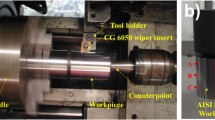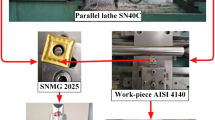Abstract
The paper evaluates issues of technological parameters optimization of the machining process of parts operating under alternating loads. It is noted that high cyclic loads on the part during operation often lead to their failure. It is suggested that the finishing of such parts should be carried out by a turning tool, the cutting part of which is made of superhard materials. The main task of this work is formulated, which is the determination of the optimal modes of turning for the part made of the corresponding structural material, which provides the specified quality parameters. To solve this problem, we created a mathematical model of the turning process, which is multicriteria, in which the criteria of optimality selected as maximum values of cyclic durability and productivity of the process. The area of feasible solutions to the optimization problem is provided by the necessary values of the quality parameters of the workpiece and the technical capabilities of the equipment used. Practical testing of the proposed method of optimization of finishing turning with a tool made of cubic boron nitride of 37Cr4(DIN) steel parts, working in difficult operating conditions, showed its great efficiency.
Access this chapter
Tax calculation will be finalised at checkout
Purchases are for personal use only
Similar content being viewed by others
References
Christ, H.-J.: Fatigue of Materials at Very High Numbers of Loading Cycles. Springer, Heidelberg (2018)
M’Saoubi, J.C., Outeiro, H., Chandrasekaran, O.W., Dillon Jr., Jawahir, I.S.: A review of surface integrity in machining and its impact on functional performance and life of machined products. Int. J. Sustain. Manuf. 1(1/2), 203–236 (2008)
Barandych, K.S., Vysloukh, S.P., Antonyuk, V.S.: Ensuring fatigue life of parts during finish turning with cubic boron nitride tools. J. Superhard Mater. 40, 206–215 (2018). https://doi.org/10.3103/S1063457618030085
Robinson, J.S., Tanner, D.A., Truman, C.E., Wimpory, R.C.: Measurement and prediction of machining induced redistribution of residual stress in the aluminium alloy 7449. Exp. Mech. 51(6), 981–993 (2011). https://doi.org/10.1007/s11340-010-93
Belgasim, O., El-Axir, M.H.: Modeling of residual stresses induced in machining aluminum magnesium alloy (Al-3 Mg). In: Proceedings of the World Congress on Engineering 2010, WCE 2010, London, U.K., pp. 148–156 (2010)
Sasahara, H.: The effect on fatigue life of residual stress and surface hardness resulting from different cutting conditions of 0.45% steel. Int. J. Mach. Tools Manuf. 45(2), 131–136 (2005). https://doi.org/10.1016/j.ijmachtools.2004.08.002
Zhou, J., Bushlya, V., Peng, R.L., Chen, Zh., Johansson, S., Stahl, J.E.: Analysis of subsurface microstructure and residual stresses in machined Inconel 718 with PCBN and Al2O3-SiCw tools. In: 2nd CIRP Conference on Surface Integrity (CSI), pp. 150–155 (2014). https://doi.org/10.1016/j.procir.2014.04.026
Guo, Y.B., Li, W., Jawahir, I.S.: Surface integrity characterization and prediction in machining of hardened and difficult-to-machine alloys: a state-of-art research and analysis. Mach. Sci. Technol. 13, 437–470 (2009). https://doi.org/10.1016/j.procir.2013.03.046
Zawada-Tomkiewicz, A.: Analysis of surface roughness parameters achieved by hard turning with the use of PCBN tools. Est. J. Eng. 17(1), 88–99 (2011). https://doi.org/10.3176/eng.2011.1.09
Kevin, Y., Evans, C.J., Barashb, M.M.: Experimental investigation on cubic boron nitride turning of hardened AISI 52100 steel. J. Mater. Process. Technol. 134(1), 1–9 (2003). https://doi.org/10.1016/s0924-0136(02)00070-5
Klymenko, S., Kopeikina, M.: Improvement of technologies for edge cutting machining with tools equipped with superhard structured composites. Modern manufacturing process and systems: collective monograph. SaTCIP Publisher Ltd, Moscow (Russia)-Belgrade-Vrnjačka Banja (Serbia) (2020)
Athmane Yallese, M., Chaoui, K., Zeghibb, N., Boulanouar, L., Rigal, J.-F.: Hard machining of hardened bearing steel using cubic boron nitride tool. J. Mater. Process. Technol. 209(2), 1092–1104 (2009). https://doi.org/10.1016/j.jmatprotec.2008.03.014
Volkogon, V.M., Antonyuk, V.S.: The effect of grafite-like boron nitride to the formation of residual stresses, strength, and performance of materials based on wurtzitic boron bitride. J. Superhard Mater. 23(5), 50–53 (2001)
Borovskii, G.V., Pini, B.E., Khachikyan, E.A.: High-speed precision machining of hardened steels using small-sized cBN tools. Izv. MGTU “MAMI” 2(14), 30–38 (2012). (in Russian)
Samanta, B.: Surface roughness prediction in machining using soft computing. Int. J. Comput. Integr. Manuf. 22(3), 257–266 (2009). https://doi.org/10.1080/09511920802287138
Kadirgama, K., Noor, M.M., Zuki, N.M., Rahman, M.M., Rejab, M.R.M., Daud, R., Abou-El-Hossein, K.A.: Surface roughness prediction model of 6061-T6 aluminum alloy machining using statistica l method. Eur. J. Sci. Res. 25(2), 250–256 (2009)
Vyslokh, S.P.: Information technology in the tasks of technological preparation of the adjunct of machine-excitation technology: monograph. NTUU “KPI”, Kyev (2011). (in Ukrainian)
Visloukh, S.P.: Determination of process parameters of new tool. J. Superhard Mater. 23(5), 65–69 (2001)
Dalsky, A.M., Suslov, A.G., Kasilov, A.G., Meshcheryakov, R.K.: Reference technologist-mechanical engineer. V.2. Mechanical Engineering-1, Moscow (2003). (in Russian)
Kheifetz, M.L., Vasilyev, A.S., Klimenko, S.A.: Technological control of the heredity of operational quality parameters for machine parts. Adv. Mater. Technol. 2, 8–18 (2019). https://doi.org/10.17277/amt.2019.02.pp.008-018
Author information
Authors and Affiliations
Corresponding author
Editor information
Editors and Affiliations
Rights and permissions
Copyright information
© 2021 The Author(s), under exclusive license to Springer Nature Switzerland AG
About this paper
Cite this paper
Antonyuk, V., Barandych, K., Vysloukh, S. (2021). Multicriteria Optimization of the Part’s Finishing Turning Process Working in the Conditions of Alternating Loadings. In: Tonkonogyi, V., et al. Advanced Manufacturing Processes II . InterPartner 2020. Lecture Notes in Mechanical Engineering. Springer, Cham. https://doi.org/10.1007/978-3-030-68014-5_48
Download citation
DOI: https://doi.org/10.1007/978-3-030-68014-5_48
Published:
Publisher Name: Springer, Cham
Print ISBN: 978-3-030-68013-8
Online ISBN: 978-3-030-68014-5
eBook Packages: EngineeringEngineering (R0)




